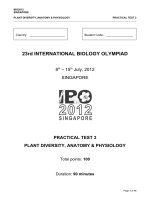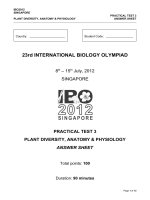Avian anatomy and physiology
Bạn đang xem bản rút gọn của tài liệu. Xem và tải ngay bản đầy đủ của tài liệu tại đây (7.03 MB, 49 trang )
Avian Anatomy and
Physiology
Christine Fiorello, DVM, PhD, Dipl. ACZM
Some slides from Heather Wilson, DVM, Dipl. ABVP Avian
Integument
¾ 2 layers: Dermis and
epidermis
¾ Epidermis thin except for
certain areas
¾ Keratinization produces
special structures: beak,
nails, scales, feathers
¾ Lacks glands
Feathers-7 types
¾ Contour
wing & tail
(flight)
¾ Semiplume
¾ Down
fluffy, no
barbules
¾ Bristle
“eyelashes”
¾ Powder down
¾ Hypopenna
¾ Filoplume
Uropygial Gland
¾ “Preen gland”
¾ Bilobed holocrine gland
¾ Conditions feathers
¾ Not all species have one
Purpose of
Feathers
¾ Flight
¾ Courtship
¾ Defense
¾ Insulation
¾ Waterproofing
Contour
Feathers
¾ Rows (pterylae)
in most species
¾ Apteryla=featherless tracts
¾ Remiges=Wing
flight feathers
¾ Retrices=Tail
flight feathers
Primaries attach to metacarpals
Secondaries attach to ulna
Waterproofing
¾ Preen gland secretions
are not necessary
¾ Interlocking of feather
barbules creates
watertight barrier
Musculoskeletal
System
Notarium
Synsacrum
Coccygeal
Avian wings
¾ Unique structure
¾ Flight feathers
attached to ulna
and metacarpals
¾ Ulna > radius
Bat
Pterodactyl
Superman
Pectoral girdle
Clinical skeletal anatomy
¾ Spinal fractures
at juncture of
notarium and
synsacrum
¾ See with birds
who flew into a
window
Fractures
¾ Bones are more brittle
compared to mammals
¾ Bones heal more rapidly
ã 4 weeks
ắ Fibrocartilagenous healing
first
ã may not be visible
radiographically
Pectoral Muscle
¾ Highly vascularized
muscle
¾ IM injections here
are absorbed rapidly
¾ Nonflighted birds
have soft, “flabby”
pectoral muscles
Lower limbs
¾ Femur
¾ Tibiotarsus
¾ Tarsometatarsus
“Hock” is
tibiotarsaltarsometatarsal
joint
Feet
¾ Each digit has +1
phalanx
Digit one has 2
phalanges
Digit two has 3, etc
¾ Parrots are
zygodactylus
Digits 1 & 4 face back
Digits 2 & 3 face forward
Cardiovascular system
¾ 4 chambered
heart
¾ Encircled by
liver
¾ Right jugular
vein larger
than left
(which may be
absent)
Lymphatic System
¾ No lymph nodes
¾ Lymph vessels follow veins
¾ Lymph plexuses (rete)
¾ Bursa of
Fabricius
B-cells
Kidneys
¾ Adhered to
dorsal body
wall
¾ Retroperitoneal
¾ 3 lobes
¾ Excrete uric
acid and some
urine
Renal Portal System
Nervous System
¾ Brain: 3 meniges & 12 CN as in mammals
¾ In contrast, birds have no neocortex
¾ Surface of cerebrum almost smooth
¾ Olfactory bulb relatively small
Bird
Mammal
Bird Brain
Eyes
¾ Most birds have excellent vision
¾ More cones than rods (in general)
¾ No blind spot (no optic disk)
Pecten, unique to birds, provides nutrients
¾ Iris contains striated muscle--
can’t use atropine to dilate
Need curariform drugs









